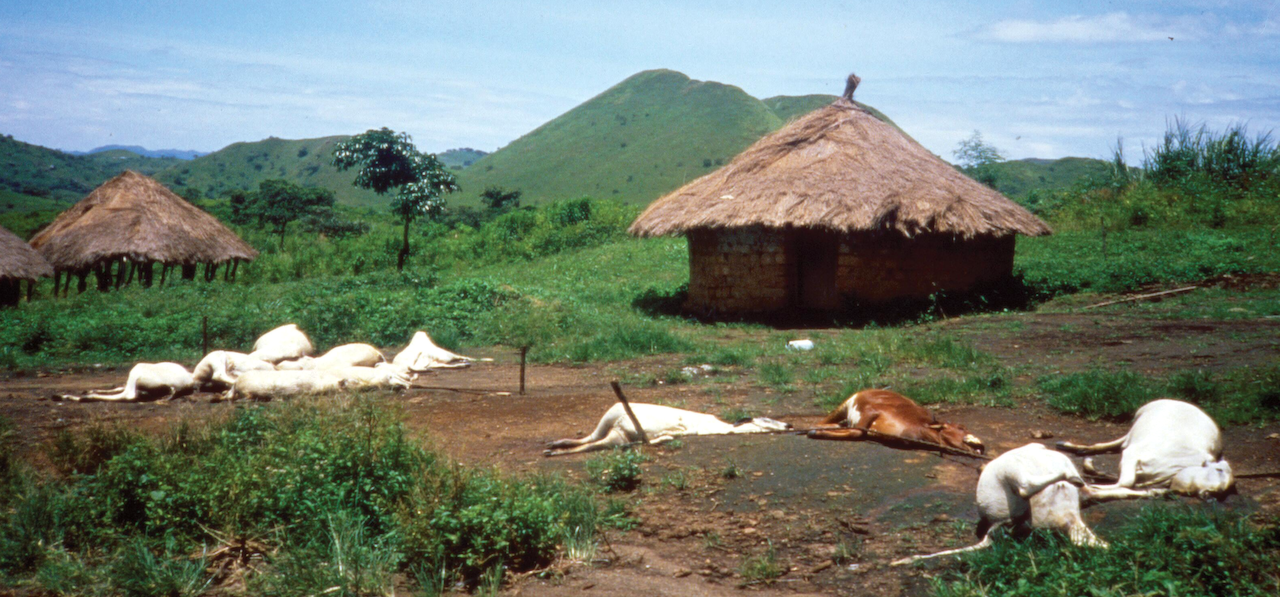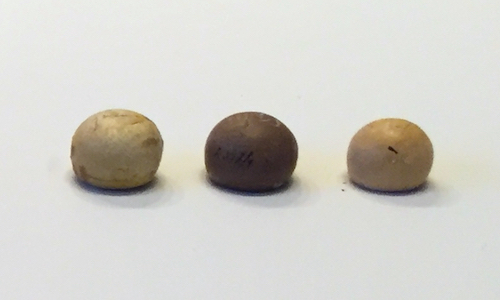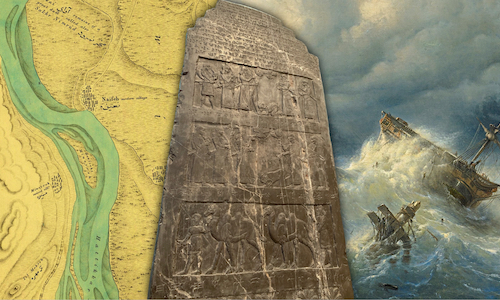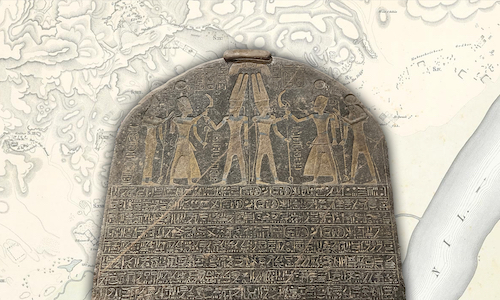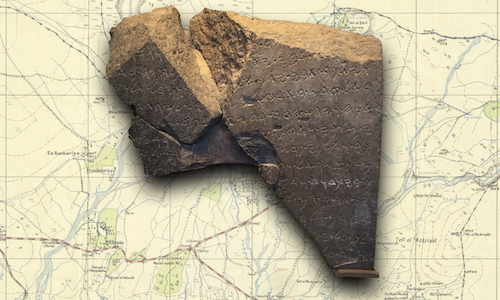Continuing our critical assessment of the scientific explanation for the ten plagues in “The Exodus Decoded” – Plagues 2 to 6
In the previous post we began our critical look at Simcha Jacobovici’s “comprehensive scientific explanation” for the 10 plagues in his 2006 Exodus Decoded documentary. We only got as far as covering his ideas on the first plague before giving up in disgust. In this post we’ll continue; starting with the 2nd plague we’ll work our way through to the 6th.
This post is going to be a little different to the last one. Previously we had to go through reports of what happened at the 1986 Lake Nyos disaster in Cameroon, studies of iron levels in the Nile, and fault-line maps of north-eastern Africa. This time we need nothing but to use our brains.
Let’s get started.
Plague 2 – Frogs
In the Exodus narrative, seven days after the waters of Egypt waere turned to blood (Ex 7:25), God sent Moses to speak to Pharaoh with the warning that if the Israelites were not freed, “I will plague your whole country with frogs.” Pharaoh was told to expect the frogs to come out of the river and spread everywhere, from Pharaoh’s own bed to the ovens and kneading bowls of the people of Egypt.
The text doesn’t mention a response from Pharaoh; Aaron just got on with it. He stretched out his hand over the waters of Egypt and the frogs came out of the water and “covered the land of Egypt”.
The Egyptian magicians managed to pull off the same trick, bringing their own plague of frogs on the land of Egypt. Pharaoh then summoned Moses and asked that he’d pray to God the next day for the removal of the frogs.
The next day God answered Moses’ prayer and the frogs died where they were – in houses, courtyards, and fields. The Egyptians gathered the dead frogs into great big piles, “and the land stank.”
Bearing in mind the explanation for the water turning to blood that we covered in the previous post, how does Jacobovici’s “comprehensive scientific explanation” for the ten plagues answer the plague of frogs? He explains,
The first thing that happens in such circumstances is that the water becomes devoid of oxygen, and all living things in it die… The only things that do not die are frogs. Unlike fish they can hop out, and as it turns out biblical plague number two is a frog infestation.
Well, if that counts as “scientific” then my pointing out Mars and Jupiter in the night sky to my two young boys makes me an astrophysicist.
Scientific objections
If we don’t think about it too much, the explanation that everything-died-in-the-river-apart-from-the-frogs-because-frogs-can-jump-out-of-the-river seems plausible. I mean, frogs can jump out of rivers but fish can’t.
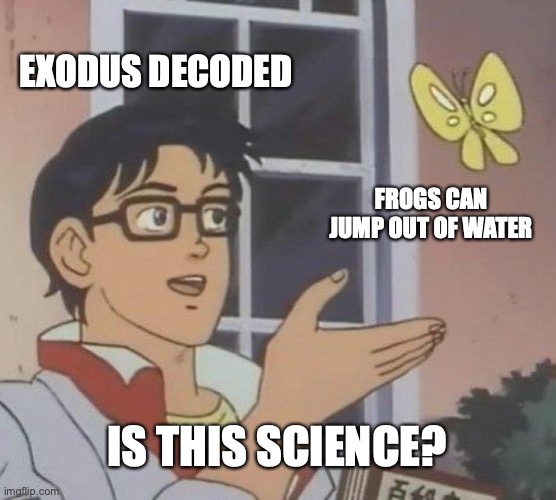
If we think about it for around 0.75 seconds… if the Nile turned reddish-brown because of CO2 bubbling up from (non-existent) fault lines beneath the river disturbing a (non-existent) hypolimnion containing dissolved iron (which doesn’t happen in the Nile), then that same CO2 would have killed a large proportion of the frogs that hopped out of the water. After all, the CO2 released during the Lake Nyos disaster caused the death of almost 4,000 cows – frogs aren’t going to have an easier time of a massive wall of CO2. They’d probably have been more likely to survive by staying in the water.
Biblical objections
Though Jacobovici stands in a long tradition of seeing the first plague as the cause of the second,1 that idea certainly isn’t found in the text. In fact, the opposite is true; this is best demonstrated by taking a look at the timeline:
Ex 7:25–8:2 Seven days passed after the LORD had struck the Nile. Then the LORD said to Moses, “Go to Pharaoh and say to him, ‘…I will plague your whole country with frogs…’”
This clearly doesn’t line up with Jacobovici’s explanation. He has the frogs jumping out of the water as soon as it turned reddish-brown, but the biblical text has the frogs hopping out a whole week after the water turned to blood (and, in the biblical narrative they don’t hop out of the river in response to a change in the river).
The next objection revolves around where the frogs came from. Here’s what Moses told Aaron to do:
Ex 8:5 Stretch out your hand with your staff over the rivers, the canals, and the pools, and make frogs come up on the land of Egypt.
Rather like the difficulty for Jacobovici’s explanation of the water in the water pots turning reddish-brown in the first plague, for this second plague we’ve got frogs hopping out of pools. These pools of water unconnected to the Nile would presumably not have turned reddish-brown from the iron-hydroxide thing. So why would the frogs hop out of pools of perfectly good water in plague proportions?
It’s also clear from the Exodus record that the river was not emptied of frogs – plenty stayed behind. The frogs came up out of the rivers, canals, and pools, but they did not return to them. Instead, the plague was brought to an end when,
Ex 8:13–14 …the frogs died in the houses, the courtyards, and the fields. And they gathered them together in heaps, and the land stank.
By the end of it, the only frogs that remained were those that had remained in the Nile the whole time:
Ex 8:10–11 So that you may know that there is no one like the LORD our God, the frogs shall leave you and your houses and your officials and your people; they shall be left only in the Nile.
So, were the frogs the only survivors of the CO2/iron-hydroxide thing because they hopped out? Or, as the biblical record indicates, did a whole load of them remain in the Nile the whole time? If, as scripture indicates, they had remained in the Nile, how did they survive the CO2 poisoning and iron hydroxide thing? That’s the whole point of this comprehensive scientific explanation, right?

Finally, let’s not forget that,
Ex 8:7 …the magicians did the same by their secret arts, and brought frogs up on the land of Egypt.
Either the frogs immediately hopped out of the Nile as a result of its turning reddish-brown, as Jacobovici claims, or the magicians, using secret art, caused them to come out of the rivers, canals, and pools several days after the water was turned to blood, as the Exodus record states.
Once again, Jacobovici’s proposed explanation doesn’t match the details in the biblical text. It’s not event close.
Plague 3 – Gnats
The biblical record of the third plague is considerably shorter than the first two.
Pharaoh was given no warning. There was no demand to “let my people go.” God simply instructed Moses to tell Aaron to hit the “the dust of the earth.” When he did, “all the dust of the earth turned into gnats throughout the whole land of Egypt.” The gnats then plagued both humans and animals alike.
For the first time, the Egyptian magicians weren’t able to replicate the plague, declaring it to be “the finger of God.”
Jacobovici explains,
The lack of clean water then leads to lice, flies, and bacterial epidemics among humans and domestic animals. Not surprisingly, biblical plague number three is lice.
Scientific objections
So… unclean water causes plagues-levels of gnats!? Just on the face of it this claim is ridiculous and deserves no more time than its already had.
It should be noted that there isn’t a single mention of gnats (or mosquitoes, or flies, or anything else like that) in any of the reports on the Lake Nyos disaster.
Biblical objections
Compared to Jacobovici’s explanation that the gnats were a natural result of the presence of unclean water, the biblical picture is completely different. In Exodus we read that the gnats were caused by Aaron hitting the ground with his staff; the Egyptian magicians recognised the event as “the finger of God”, not a natural event.
Once again, the “comprehensive scientific explanation” doesn’t explain what’s described in the text.
Plague 4 – Flies
Quick aside: I’ve experienced a plague of flies while camping along Australia’s southern coast, and let me tell you, it’s no fun. We had to abandon our tent and go find a hotel to sleep in. We locked ourselves behind the fly screen and survived on beer –the only thing we could think to grab from our tent before driving off– until the next morning. Anyway…
The record in Exodus doesn’t explain how the previous plague of gnats ended; it just rolls straight into the fourth plague.
In Ex 8:20 Moses was told to go to Pharaoh the next day and speak to him as he went into the river – just like the first plague. Moses warned Pharaoh that if he didn’t let the Israelites go that there’d be a plague of flies that would affect the whole land of Egypt.
The next day, “great swarms of flies” “ruined” “all of Egypt” (8:24). Pharaoh summoned Moses who agreed to request of God that the flies would leave the next day. And so they did.
Jacobovici’s explanation for this plague is the same as that for the gnats:
The lack of clean water then leads to lice, flies, and bacterial epidemics among humans and domestic animals. Not surprisingly, biblical plague number three is lice. Plague number four is flies.
That’s it. “Comprehensive”, huh. Just like the gnats, a fly infestation of plague proportions occurred because… the water had some rust in it.
Scientific objections
The Exodus record states that this plague would not affect the land of Goshen where the Israelites lived. Yet, if the flies were caused by unclean water, and all the water in Egypt (including the water jars!) had turned to blood/contained some rust, then all the water including that in Goshen would have been affected and there would be no reasonable “scientific” explanation for Goshen to be spared a fly infestation. Yet the record clearly states that Goshen was spared the flies, “that you may know that I Yahweh am in this land.” Jacobovici’s explanation just doesn’t match reality.
Biblical objections
If rotting fish were floating on the river, and the water beneath them was reddish brown, would anyone think the Nile would be suitable for bathing in? Probably not. Yet, God told Moses to speak to Pharaoh just as he was doing exactly that: “…present yourself before Pharaoh, as he goes out to the water…” (Ex 8:20). What’s clear here is that the picture painted in the biblical record is incompatible with the assumptions baked into Jacobovici’s explanation for the plague. Far from the water bring unclean, we find Pharaoh bathing in it, just as he had been when Moses warned him of the first plague (Ex 7:14). And if the water is clean, there isn’t a triggered-by-unclean-water plague of flies.
“Comprehensive scientific explanation” indeed…
Plague 5 – Livestock diseased
Moses was sent to tell Pharaoh that the following day a “deadly pestilence” would fall on the livestock that were outdoors. Victims of the plague were to include horses, donkeys, camels, cows, sheep, and goats, but only those that belonged to Egyptians. Livestock owned by Israelites would be spared. The next day, “all the livestock of the Egyptians died, but of the livestock of the Israelites not one died” (Ex 9:6).
Jacobovici’s explanation?
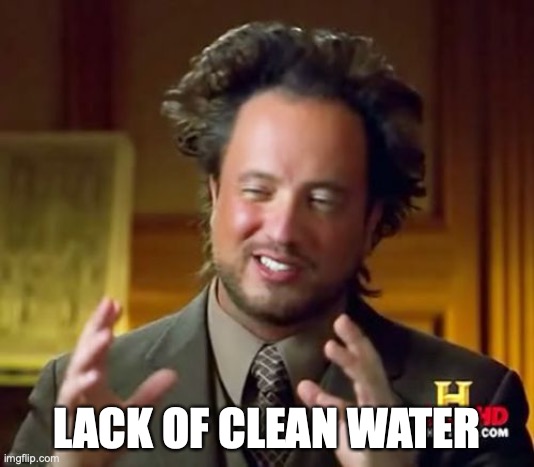
The lack of clean water then leads to lice, flies, and bacterial epidemics among humans and domestic animals. Not surprisingly, biblical plague number three is lice. Plague number four is flies. Plague number five is an epidemic.
That’s right, “an epidemic.”
Scientific objections
Interestingly, Jacobovici doesn’t mention the thousands of animals that died from the Lake Nyos disaster. As we saw in the previous post,
3952 cows, 552 goats, 337 sheep and 3404 fowl also died.2
Why doesn’t Jacobovici link these deaths with the plague suffered by the livestock? Probably because the animals that died at Lake Nyos did so as a result of CO2 poisoning, and that within hours of the CO2 release – but this 5th plague happened at least weeks after the 1st plague purportedly caused by a CO2 release.
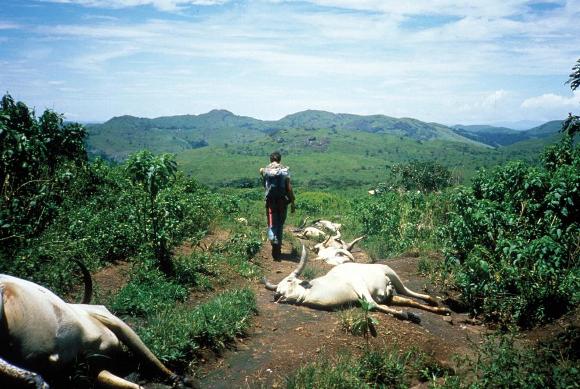
Another reason he may not have linked the animal death caused by the Lake Nyos disaster with the 5th plague can be found in a plain reading of the biblical text…
Biblical objections
Biblically speaking, the ‘deadly pestilence’ did not affect all livestock. Which horses, cows, and sheep were affected was based not on their location as was the previous plague of flies, but on their ownership:
Ex 9:6 …all the livestock of the Egyptians died, but of the livestock of the Israelites not one died.
Though “it is not possible to identify the precise disease on the basis of information given in the Bible”,3 whatever disease it was meant to have been, the natural world is not aware of an ownership-based disease. So for Jacobovici to suggest that the 6th plague was the natural result of unclean water is just bonkers. It doesn’t fit with the biblical description.
Plague 6 – Boils
The biblical description is short: with Pharaoh looking on, Moses and Aaron took handfuls of soot from a kiln and threw it in the air. The airborne soot spread across all Egypt and caused humans and animals to develop “festering boils”.
Just like plagues 2-5, Jacobovici states that this 6th plague too was caused by unclean water:
The lack of clean water then leads to lice, flies, and bacterial epidemics among humans and domestic animals. Not surprisingly, biblical plague number three is lice. Plague number four is flies. Plague number five is an epidemic. Plague six is boils and blisters – man and beast.
Unlike plagues 2-5, Jacobovici links back to the Lake Nyos disaster covered in the first post. He continues,
Can an earthquake induced gas leak explain this kind of outbreak? Let’s go back to the 1986 disaster at Lake Nyos, Cameroon. At the time, people living along the lake develop strange boils and burns. It turns out that carbon dioxide mixed with air put people into a kind of coma, reducing circulation to the skin, and causing the kind of boils described in the Bible as plague number 6.
So, at least there’s something to work with here.
Scientific objections
OK, Jacobovici has a point – there is evidence that humans who survived the Lake Nyos disaster suffered from blisters. But, how many? Everyone? Most of them? Half of them? No. As Baxter and Kapila explain,
Unequivocal evidence of blistering or ulceration of the skin was present in 36 (7%) of 548 in-patients4
7% hardly explains “all the Egyptians” suffering from boils (Ex 9:11).
Let’s expand it out a bit – let’s pretend that we can count burns as boils. How many burns were recorded amongst the Lake Nyos survivors?
Skin lesions resembling burns were recorded in 19% of the survivors overall and these were mostly redness of the skin… Virtually all of the victims with skin lesions had reported a period of unconsciousness… Most of the lesions were superficial…5
Again, 19% is hardly “all the Egyptians”. Also, it sounds like the majority of the burns that were suffered could hardly be described as being similar to what we’d expect from a plague sent by God.
Jacobovici also claims the following:
It turns out that carbon dioxide mixed with air put people into a kind of coma, reducing circulation to the skin, and causing the kind of boils described in the Bible as plague number 6.
But when you read the literature you find something else:
Prolonged states of unconsciousness and skin blisters have not been recorded with CO2.6
Quite simply, CO2 poisoning does not cause the boils suffered by the Egyptians in the sixth plague. Those that did suffer from blisters at Lake Nyos did so on specific parts of the body:
A common site for the skin lesions was over the cheekbone of the face or other likely pressure points or skin sites with poor circulation (e.g. shins and feet).7
This isn’t a plague; it’s people’s skin being damaged in places that hit the ground as they fell unconscious.
Biblical objections
The most obvious biblical objection to Jacobovici’s explanation comes from the timeline. In the Exodus narrative the sixth plague happens many days after the onset of the first plague. If a “comprehensive scientific explanation” is to be given, it needs to take that into account.
Jacobovici appeals to the evidence of the blisters and burns suffered by victims and survivors of the Lake Nyos disaster. But, what isn’t mentioned is that those symptoms developed within minutes or hours of the CO2 poisoning suffered by the Cameroonians – not days or weeks as the biblical timeline demands. Had the cause of the 6th plague been the same cause of the 1st plague – CO2 bubbling up beneath the Nile – the 6th plague would have affected the Egyptians only moments after the 1st plague, not days or weeks.
Next, as we saw above, the unfortunate people caught up in the Lake Nyos disaster did suffer from blisters. But,
Virtually all of the victims with skin lesions had reported a period of unconsciousness…8
There’s no mention of unconsciousness in the biblical record – only boils.
What about the animals? Scripture states that the soot thrown by Moses and Aaron “caused festering boils on humans and animals” (Ex 9:10), yet the animals caught up in the disaster at Lake Nyos weren’t affected by blisters or burns. As Baxter and Kapila explain,
Human skin readily blisters in response to environmental damage from agents such as heat or chemicals which is not the case for the skin of many animals, including cattle; thus the absence of blisters or other skin lesions on the cattle corpses is not surprising.9
A final objection (that any viewer of Exodus Decoded should have immediately spotted): the explanation falsely equates boils with blisters and burns. Scripture talks about one, Jacobovici talks about the others. Of the various symptoms suffered by those caught up in the Lake Nyos disaster (burns, paralysis, cough, vomiting, diarrhoea, weakness, headache, fever, etc), boils is not one of them.
As explanations for the sixth plague go, Jacobovici’s is woefully inadequate.
Conclusion
As we’ve seen, it takes very little mental effort to realise that the “explanations” for the biblical plagues are just plain nonsense.
Are we done? No; there’s life in this dead horse yet…
In the next instalment we’ll take a look at Jacobovici’s “comprehensive scientific explanation” of the 7th and 8th plagues. Bring valium.
Further reading
If you want to read a “comprehensive scientific explanation” for something, maybe try the following:
- Fiona Watt, “That’s not my dinosaur, its body is too squashy” (Usborne, 2020)
- Katrina Charman, “Car, Car, Truck, Jeep” (Bloomsbury Children’s Books, 2018)
These are all improvements on Exodus Decoded.
Featured image
Dead cattle and surrounding compounds in Nyos village. Public domain - source.
Footnotes
-
“Rationalist commentators often connect the plagues of blood and frogs causally. If the fish died (7:21), presumably the frogs came up on the land to escape the pollution. It is not impossible that the biblical authors, too, made some such connection, but the text is silent.” William H. C. Propp, Exodus 1–18: A New Translation with Introduction and Commentary, vol. 2, Anchor Yale Bible (New Haven; London: Yale University Press, 2008), 350. ↩
-
Samuel J. Freeth, “The Lake Nyos Disaster,” in Natural Hazards In West and Central Africa, eds. Samuel J. Freeth, Charles O. Ofoegbu K. Mosto Onuoha (Vieweg, 1992), 66. ↩
-
Günter Mayer, “דֶּבֶר,” ed. G. Johannes Botterweck and Helmer Ringgren, trans. John T. Willis and Geoffrey W. Bromiley, Theological Dictionary of the Old Testament (Grand Rapids, MI; Cambridge, U.K.: William B. Eerdmans Publishing Company, 1978), 126. ↩
-
Peter J. Baxter and Mukesh Kapila, “Acute health impact of the gas release at Lake Nyos, Cameroon, 1986,” Journal of Volcanology and Geothermal Research (Nov), Vol. 39, No. 2-3 (1989): 270. DOI: 10.1016/0377-0273(89)90064-4 ↩
-
Ibid., 269-270. ↩
-
Ibid., 272. ↩
-
Ibid., 270. ↩
-
Ibid. ↩
-
Ibid., 272. ↩
